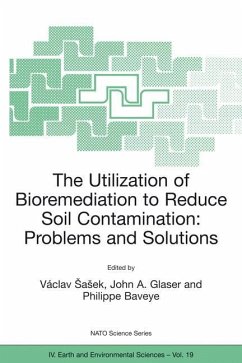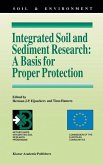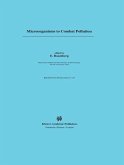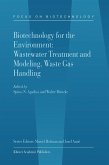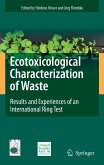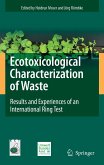Václav Sasek / John A. Glaser / P. Baveye (eds.)
The Utilization of Bioremediation to Reduce Soil Contamination: Problems and Solutions
Herausgegeben:Sasek, Václav; Glaser, John A.; Baveye, P.
Václav Sasek / John A. Glaser / P. Baveye (eds.)
The Utilization of Bioremediation to Reduce Soil Contamination: Problems and Solutions
Herausgegeben:Sasek, Václav; Glaser, John A.; Baveye, P.
- Broschiertes Buch
- Merkliste
- Auf die Merkliste
- Bewerten Bewerten
- Teilen
- Produkt teilen
- Produkterinnerung
- Produkterinnerung
Traditional reliance on chemical analysis to understand the direction and extent of treatment in a bioremediation process has been found to be inadequate. Whereas the goal of bioremediation is toxicity reduction, few direct, reliable measures of this process are as yet available. Another area of intense discussion is the assessment of market forces contributing to the acceptability of bioremediation. Finally, another important component is a series of lectures and lively exchanges devoted to practical applications of different bioremediation technologies. The range of subjects covers a wide…mehr
Andere Kunden interessierten sich auch für
![The Utilization of Bioremediation to Reduce Soil Contamination: Problems and Solutions The Utilization of Bioremediation to Reduce Soil Contamination: Problems and Solutions]() V clav Sasek / John A. Glaser / P. Baveye (Hgg.)The Utilization of Bioremediation to Reduce Soil Contamination: Problems and Solutions154,99 €
V clav Sasek / John A. Glaser / P. Baveye (Hgg.)The Utilization of Bioremediation to Reduce Soil Contamination: Problems and Solutions154,99 €![Integrated Soil and Sediment Research: A Basis for Proper Protection Integrated Soil and Sediment Research: A Basis for Proper Protection]() Integrated Soil and Sediment Research: A Basis for Proper Protection231,99 €
Integrated Soil and Sediment Research: A Basis for Proper Protection231,99 €![Slope Stability and Erosion Control: Ecotechnological Solutions Slope Stability and Erosion Control: Ecotechnological Solutions]() Joanne E. Norris / Alexia Stokes / Slobodan B. Mickovski / Erik Cammeraat / Rens van Beek / Bruce C. Nicoll / Alexis Achim (eds.)Slope Stability and Erosion Control: Ecotechnological Solutions180,99 €
Joanne E. Norris / Alexia Stokes / Slobodan B. Mickovski / Erik Cammeraat / Rens van Beek / Bruce C. Nicoll / Alexis Achim (eds.)Slope Stability and Erosion Control: Ecotechnological Solutions180,99 €![Microorganisms to Combat Pollution Microorganisms to Combat Pollution]() RosenbergMicroorganisms to Combat Pollution154,99 €
RosenbergMicroorganisms to Combat Pollution154,99 €![Biotechnology for the Environment: Wastewater Treatment and Modeling, Waste Gas Handling Biotechnology for the Environment: Wastewater Treatment and Modeling, Waste Gas Handling]() Spiros AgathosBiotechnology for the Environment: Wastewater Treatment and Modeling, Waste Gas Handling117,99 €
Spiros AgathosBiotechnology for the Environment: Wastewater Treatment and Modeling, Waste Gas Handling117,99 €![Ecotoxicological Characterization of Waste Ecotoxicological Characterization of Waste]() Ecotoxicological Characterization of Waste180,99 €
Ecotoxicological Characterization of Waste180,99 €![Ecotoxicological Characterization of Waste Ecotoxicological Characterization of Waste]() Ecotoxicological Characterization of Waste180,99 €
Ecotoxicological Characterization of Waste180,99 €-
-
-
Traditional reliance on chemical analysis to understand the direction and extent of treatment in a bioremediation process has been found to be inadequate. Whereas the goal of bioremediation is toxicity reduction, few direct, reliable measures of this process are as yet available. Another area of intense discussion is the assessment of market forces contributing to the acceptability of bioremediation. Finally, another important component is a series of lectures and lively exchanges devoted to practical applications of different bioremediation technologies. The range of subjects covers a wide spectrum, encompassing emerging technologies as well as actual, full-scale operations. Examples discussed include landfarming, biopiling, composting, phytoremediation and mycoremediation. Each technology is explored for its utility and capability to provide desired treatment goals.
Advantages and limitations of each technology are discussed. The concept of natural attenuation is also critically evaluated since in some cases where time to remediation is not a significant factor, it may be an alternative to active bioremediation operations.
Advantages and limitations of each technology are discussed. The concept of natural attenuation is also critically evaluated since in some cases where time to remediation is not a significant factor, it may be an alternative to active bioremediation operations.
Produktdetails
- Produktdetails
- Nato Science Series: IV: 19
- Verlag: Springer / Springer Netherlands
- Artikelnr. des Verlages: 978-1-4020-1142-9
- Softcover reprint of the original 1st ed. 2003
- Seitenzahl: 440
- Erscheinungstermin: 28. Februar 2003
- Englisch
- Abmessung: 235mm x 155mm x 24mm
- Gewicht: 661g
- ISBN-13: 9781402011429
- ISBN-10: 1402011423
- Artikelnr.: 23025994
- Nato Science Series: IV: 19
- Verlag: Springer / Springer Netherlands
- Artikelnr. des Verlages: 978-1-4020-1142-9
- Softcover reprint of the original 1st ed. 2003
- Seitenzahl: 440
- Erscheinungstermin: 28. Februar 2003
- Englisch
- Abmessung: 235mm x 155mm x 24mm
- Gewicht: 661g
- ISBN-13: 9781402011429
- ISBN-10: 1402011423
- Artikelnr.: 23025994
Rapid Detection/Identification of Microbes, Bacterial Spores, Microbial Communities, and Metabolic Activities in Environmental Matrices.- Comparison of Effective Organisms in Bioremediation Processes: Potential Use of Nucleic Acid Probes to Estimate Cyanide Degradation in Situ.- Modern Methods for Estimating Soil Microbial Biomass and Diversity: An Integrated Approach.- Recent Advances in the Biodegradation of Polycyclic Aromatic Hydrocarbons by Mycobacterium Species.- Toxic Metal Contamination Treatment with Microbes.- Aerobic Biodegradation of Polychlorinated Biphenyls (PCBs): The Fate, Distribution, Kinetics and Enhancement of PCB Biodegradation Efficacy in the Bacterial Cell Suspension of Pseudomonas stutzeri.- Adsorption of Heavy Metals to Microbial Biomass: Use of Biosorption for Removal of Metals from Solutions.- Nonenzymic Degradation and Decolorization of Recalcitrant Compounds.- The Impact of Sulfonation Pattern on Indigo Degradation by Phanerochaete chrysosporium Ligninolytic Enzymes.- Screening of Fungal Strains for Remediation of Water and Soil Contaminated with Synthetic Dyes.- Effect of Countermeasures of Radionuclide Uptake by Agricultural Plants.- Low-Cost Microbiotests for Toxicity Monitoring during Bioremediation of Contaminated Soils.- Application of Bioassays for Site-Specific Risk Assessment.- Effect of PAH-Contaminated Soil on some Plants and Microorganisms.- Development of immunomicroscopic methods for bioremediation.- Ecotoxicological Evaluation of PAH-Contaminated Soil Using Earthworms.- Use of Bioassays in Determining the Ecotoxicity of Industrial Soils.- Genotoxicity Estimation in Soils Contaminated with Polycyclic Aromatic Hydrocarbons after Biodegradation.- Ecotoxicological Hazard Assessment of Solid-Phase Samples.- Monitoring of Polychlorinated Biphenyls in Slovak Freshwater Sediments: Use of Semipermeable Membrane Devices.- Biopiles for Remediation of Petroleum-Contaminated Soils: A Polish Case Study.- Why mycoremediations have not yet come into practice.- From Laboratory to Industrial Scale: Composting of Polluted Soils from Former Coal Industry and Gas Plants: Future Research Needs.- Plant Biotechnology for the Removal of Organic Pollutants and Toxic Metals from Wastewaters and Contaminated Sites: Phytoremediation.- Consideration of Plant-Based Remediation and Restoration of Contaminated Sites Containing Heavy Metals: The Canadian Experience.- Combined Removal of Oil, Toxic Heavy Metals and Arsenic from Polluted Soil.- Landfarming Framework for Sustainable Soil Bioremediation.- Spent Mushroom Substrate: White-Rot Fungi in Aged Creosote- Contaminated Soil.- Bioremediation of PCBs from Contaminated Soil.- Problems of Soil Renovation on Former Military Sites in Lithuania.- The Capacity of Agricultural Soils to Auto-Regulate Bioremediation of Olive-Mill Wastewaters.- Accumulation of Organic Contamination in Plant roots and the Influence of Plant Rhizosphere on Removal of PAH, TPH and Heavy Oil Fractions from Soil.- Perspectives of Stable Isotope Approaches in Bioremediation Research.- Screening of Litter Decomposing Fungi for Degradation of Polycyclic Aromatic Hydrocarbons (PAH), Phenanthrene and benzo[a]pyrene.- Photosystem II-Based Biosensors for Phytoremediation.- Degradation of Polychlorinated Biphenyls (PCBs) in Contaminated Soil with Horseredish Peroxidase and Peroxidase from White Radish Raphatus sativus.- Successful Challenges during the Development and Application of Innovative Processes for the Bioremediation of Soils.- Current State of Bioremediation in the Czech Republic.
Rapid Detection/Identification of Microbes, Bacterial Spores, Microbial Communities, and Metabolic Activities in Environmental Matrices.- Comparison of Effective Organisms in Bioremediation Processes: Potential Use of Nucleic Acid Probes to Estimate Cyanide Degradation in Situ.- Modern Methods for Estimating Soil Microbial Biomass and Diversity: An Integrated Approach.- Recent Advances in the Biodegradation of Polycyclic Aromatic Hydrocarbons by Mycobacterium Species.- Toxic Metal Contamination Treatment with Microbes.- Aerobic Biodegradation of Polychlorinated Biphenyls (PCBs): The Fate, Distribution, Kinetics and Enhancement of PCB Biodegradation Efficacy in the Bacterial Cell Suspension of Pseudomonas stutzeri.- Adsorption of Heavy Metals to Microbial Biomass: Use of Biosorption for Removal of Metals from Solutions.- Nonenzymic Degradation and Decolorization of Recalcitrant Compounds.- The Impact of Sulfonation Pattern on Indigo Degradation by Phanerochaete chrysosporium Ligninolytic Enzymes.- Screening of Fungal Strains for Remediation of Water and Soil Contaminated with Synthetic Dyes.- Effect of Countermeasures of Radionuclide Uptake by Agricultural Plants.- Low-Cost Microbiotests for Toxicity Monitoring during Bioremediation of Contaminated Soils.- Application of Bioassays for Site-Specific Risk Assessment.- Effect of PAH-Contaminated Soil on some Plants and Microorganisms.- Development of immunomicroscopic methods for bioremediation.- Ecotoxicological Evaluation of PAH-Contaminated Soil Using Earthworms.- Use of Bioassays in Determining the Ecotoxicity of Industrial Soils.- Genotoxicity Estimation in Soils Contaminated with Polycyclic Aromatic Hydrocarbons after Biodegradation.- Ecotoxicological Hazard Assessment of Solid-Phase Samples.- Monitoring of Polychlorinated Biphenyls in Slovak Freshwater Sediments: Use of Semipermeable Membrane Devices.- Biopiles for Remediation of Petroleum-Contaminated Soils: A Polish Case Study.- Why mycoremediations have not yet come into practice.- From Laboratory to Industrial Scale: Composting of Polluted Soils from Former Coal Industry and Gas Plants: Future Research Needs.- Plant Biotechnology for the Removal of Organic Pollutants and Toxic Metals from Wastewaters and Contaminated Sites: Phytoremediation.- Consideration of Plant-Based Remediation and Restoration of Contaminated Sites Containing Heavy Metals: The Canadian Experience.- Combined Removal of Oil, Toxic Heavy Metals and Arsenic from Polluted Soil.- Landfarming Framework for Sustainable Soil Bioremediation.- Spent Mushroom Substrate: White-Rot Fungi in Aged Creosote- Contaminated Soil.- Bioremediation of PCBs from Contaminated Soil.- Problems of Soil Renovation on Former Military Sites in Lithuania.- The Capacity of Agricultural Soils to Auto-Regulate Bioremediation of Olive-Mill Wastewaters.- Accumulation of Organic Contamination in Plant roots and the Influence of Plant Rhizosphere on Removal of PAH, TPH and Heavy Oil Fractions from Soil.- Perspectives of Stable Isotope Approaches in Bioremediation Research.- Screening of Litter Decomposing Fungi for Degradation of Polycyclic Aromatic Hydrocarbons (PAH), Phenanthrene and benzo[a]pyrene.- Photosystem II-Based Biosensors for Phytoremediation.- Degradation of Polychlorinated Biphenyls (PCBs) in Contaminated Soil with Horseredish Peroxidase and Peroxidase from White Radish Raphatus sativus.- Successful Challenges during the Development and Application of Innovative Processes for the Bioremediation of Soils.- Current State of Bioremediation in the Czech Republic.

